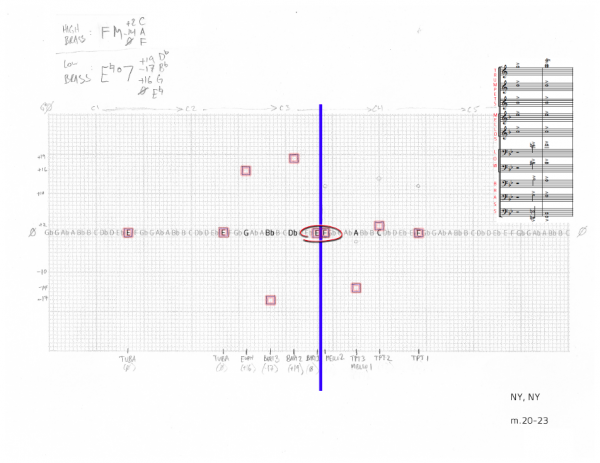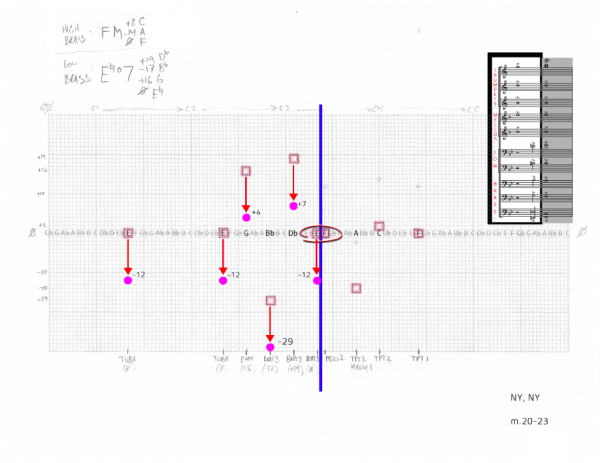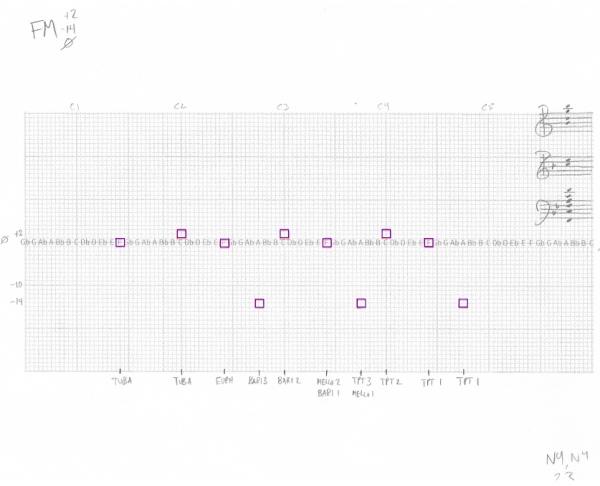There were several requests for the resolution of the chords to be included on the audio recordings.
**REQUEST GRANTED**
Below is a diagram showing the information of the FM/Edim7.

Edim7 (E=0) and FM (F=0)
[player track=”https://bradkerrgreen.com/wp-content/uploads/2011/03/FMEdim7toFM-ex1.mp3″]
Listen to mp3 Quicktime
[line]

Edim7 (E=0) and FM (FM=+12)
[player track=”https://bradkerrgreen.com/wp-content/uploads/2011/03/FMEdim7toFM-ex2.mp3″]
Listen to mp3 Quicktime
[line]

Edim7 (Edim7=-12) and FM (F=0)
[player track=”https://bradkerrgreen.com/wp-content/uploads/2011/03/FMEdim7toFM-ex3.mp3″]
Listen to mp3 Quicktime
[line]
The final example on this blog was a request from the previous FM over Edim7 entry. This example has been named “Phelan’s Equation” – after the author. Here are Phelan’s exact words:
Tune all the pitches relative to the F: Don’t worry about the chord integrity of the dim7, because it’s just there to draw attention to the eventual resolution. Treat the E as a M7 (-12?), the G as a M2 (+4), B-flat as P4 (-2), and D-flat as m6 (+14).
Now, a consequence of this is that between E/G and between B-flat/D-flat, the fraction ratios that construct the just-intonation scale preserve the proper minor-third relationship. Getting from G to B-flat (and from D-flat to E), though, must cross over the wolf fifth somehow, breaking that pure minor third.

Phelan’s Equation
[player track=”https://bradkerrgreen.com/wp-content/uploads/2011/03/FMEdim7toFM-exPhelan.mp3″]
Listen to mp3 Quicktime
PROS:
- All pitches played support F harmonic series (enhanced if a low F can be sounded about two or three octaves beneath the tuba pitch via synthesizer).
- F major triad in high brass is held constant, at normal levels of alteration, without need for further adjustment when the low brass enter.
- Pitches sounded by low brass get adjusted by comparatively small amounts, with nothing more drastic than moving something by 14 cents.
- As the dissonance is an effect whose purpose is to lead into the clarity of resolution a few bars later, it may not be necessary for the dim7 chord to sound perfectly in tune, or even in tune at all.
CONS:
- The dim7 chord will not be perfectly in tune: the pitches’ function is broken away from sounding as a chord in favor of reinforcing the F harmonic series.
- In the baritones, the E (a sharp pitch) needs to be noticeably lowered, and the D-flat (in a particularly flat partial on the Yamahas) needs to be noticeably raised. The D-flat can be fingered 2-3, placing it in the F partial, which tends sharp. This might address the issue.
- Without a reinforcement of the fundamental F beneath the low brass, it may not be clear that all pitches are being tuned in relation to that single pitch, and players (trained to listen down for intonation purposes) may have trouble finding the correct adjustments.
[line]

F Major- F=0, A=-14,C=+2
[line]
Related articles
- Adventures In Just Intonation – FM over Edim7 (bradkerrgreen.com)
- Acoustics Experiment – F Major (bradkerrgreen.com)
